In Search of a new Weird Tales: An Interview with Joseph Goodman, Howard Andrew Jones, and the Talking Skull!
Recently Goodman Games announced a Kickstarter campaign to fund the launch of Tales From the Magician’s Skull, a magazine of all-new swords & sorcery fiction in the classic pulp style. The first issue is a delight for Black Gate readers, with tales from popular BG contributors James Enge, John C. Hocking, Howard Andrew Jones, Chris Willrich, Bill Ward, and others. And best of all, Goodman has invited Howard Andrew Jones on board as editor, guaranteeing a top-notch product. The spectacular success of the Kickstarter campaign — more than quintuple its goal, with more than a week to go — demonstrates just how well the creators have read the market demand for a true sword & sorcery publication. I sat down with Joseph Goodman, founder and publisher of Goodman Games, and Howard — along with their undead master, the mighty Magician’s Skull — to find out more about one of the most exciting magazine launches in a decade.
My first question is for Joseph… why a magazine? How does that fit in with your laser-like focus on classic gaming?
Joseph: Thanks for the interview, John! To answer your question, I have to start with Appendix N. In the 1982 edition of the Advanced Dungeons & Dragons Dungeon Master’s Guide, the creator included an obscure bibliography. It was Appendix N, the 14th appendix in the book, where he listed the works of fiction that inspired him to create D&D. That list has since become notorious. It is now a de facto “required reading list” for diehard fans of the game.
Well, I read every book on the list over the course of many years, and it piqued my interest in vintage fantasy novels. The list includes names like Fritz Leiber, Robert E. Howard, H. P. Lovecraft, Jack Vance, Edgar Rice Burroughs, Abraham Merritt, Jack Williamson, Manly Wade Wellman, and others. What do these authors have in common? They got their start in pulp fantasy magazines from the early 20th century.
Learning more about the fantastic origins of D&D led me to discover pulp magazines like Weird Tales, and find that locus of fantastic inspiration that is REH, ERB, HPL, and others. And of course the artists of the era, like Virgil Finlay and Hannes Bok! In my mind, the Weird Tales style of publishing is an integral part of the creative feedback loop that creates great role playing games, and I would love to expand my game publishing to include that style of fiction.
Weird Tales, September 1934
What a great answer. I’m especially excited to hear that you haven’t forgotten about the art.
In fact, the art samples you’ve published so far (from Ian Miller, Doug Kovacs, and Brad McDevitt) have been fantastic. Tell me more about the art.
Joseph: I am a fan of “pre-digital” art, especially that of the early 20th century. Over the preceding century the look and feel of fantasy art has evolved as tools have changed. Many modern artists use digital tools to render the art: a stylus, touchscreen, Photoshop. This has changed the way colors display and the way the medium is perceived.
The great painters of the pulp era — such as Margaret Brundage, J. Allen St. John, Frank R. Paul, and others — used palettes with bright colors often grounded in primary colors. And they painted in physical media — that is, with a brush and paint — which left behind a physical artifact. We call that the “original art” — a thing that doesn’t exist with much modern fantasy art. I associate those great pulp artists strongly with the famous fiction writers whose work they illustrated, and I think their style really helped bring the work alive. I feel similarly about the great black and white artists — of course Virgil Finley and Hannes Bok. In some cases they utilized techniques that are effectively forgotten now, such as Finley’s scratch board work.
Ian Miller’s illustration for “Beneath The Bay of Black Waters”
Tales From the Magician’s Skull tries to conjure up the magic of these pulp artists. We do it by dedicating full page art to each story. We do it by focusing on physical media for the art — while some level of digital work is unavoidable these days, you can examine the art and see that it was mostly rendered with ink and brush. I may be a bit idiosyncratic but I like to see a bit of leftover pencil marks in my printed art, since it is “evidence of being” for the art — and you can find some pencil marks if you look carefully.
And finally, we have selected artists who are not “just” great artists, but who have some connection to the creative locus that is D&D and its antecedents. Jennell Jaquays, Ian Miller, Doug Kovacs, Brad McDevitt, William McAusland, Stefan Poag — many readers will already know these names. Oh, and maps! Just like some of the classic Abraham Merritt pulp stories, our stories are illustrated with maps!
Jennell Jaquays art for Tales From the Magician’s Skull
This next question is for Howard.
Joseph talks about “trying to conjure up the magic of these pulp artists” with Tales From the Magician’s Skull. Did you do the same thing with the fiction? Do you think you succeeded?
Howard: Yes, and yes. But let me be clear. We weren’t after pastiche, and we certainly didn’t seek comic send-ups. We wanted authors who had gone to the same well from which the older authors drew and used that inspiration to create exciting new fiction – tales that had a similar feel but weren’t slavish imitation. Of paramount importance was a gripping story with forward momentum and plenty of action and horror and dread. No bucolic fairy tales were sought, and magic presented in the stories isn’t some cute analog for modern day technology. That said, we also celebrate a sense of wonder. I appreciate a lot of “grimdark” fiction but at the most excessive end of that sub-genre everything’s bleak, everything’s covered in dirt and dung, and everyone’s a bastard. We didn’t want to go there, at least not with any regularity. There’s horror and grit in what we’re publishing, yes, but there are heroics as well.
And of course we wanted our writers to be free to invent. Sometimes it seems like we’re saddled with so much rich genre history that things have to be presented a certain way. The earlier creators didn’t feel constrained to, say, always present magic this way or elves that way. They did whatever they damned well pleased when they built their worlds. It was a constant pleasure to see what they devised, and we were after modern writers who could do the same thing.
Table of Contents for Issue 1
Sounds fantastic. Tell us about the fiction in the first issue.
Howard: I think the BEST way to read about the fiction in the first issue is to drop by the Kickstarter, where you can view not only the table of contents in all its pulp-like glory (courtesy of layout genius Lester Portly) but sample prose from each tale. And the sample TOC on the Kickstarter is preceded by some old-school thumbnail write-ups of each story, meant to thrill and entice the reader.
But for those of you who don’t want to click over right away, I naturally turned first to some Black Gate stalwarts. You’ll find a new Morlock story in there by James Enge. You’ll see a tale in there from Bill Ward, and one from John C. Hocking set in the same world as his Archivist stories. There’s one from me in there — accepted before I transformed into the editor of this project! — but it’s a new character and setting. Black Gate readers might remember that there was a Chris Willrich story in a later issue of Black Gate, but they might also know his long running Gaunt and Bone series from various appearances in other places, or from their Pyr novels. Aeryn Rudel’s published two novels with Privateer Press and a slew of short stories in various venues, and he’s in there with a short thriller. And last but certainly not least we have a story from Clint Werner, who’s written some of my favorite stuff for the Warhammer fiction line.
My next question is for the Magician’s Skull.
Mr. Skull sir, you are awesome. How can I get my own talking skull?? Asking for a friend.
Skull: Dare you suggest I am an acquisition? That you may own or purchase me? I shall smite your friend for his insolence! I am unique amongst all the shadows of creation! I am not a curio! These two you speak with are MY minions, working at my bidding!
Howard: In point of fact, the skull approached us, not vice versa.
Joseph: We did entertain offers from other overlords, though.
Howard: Right. But Tales From Mog, The Gorilla With Human Blood on his Diamond Fangs didn’t fit as well on the mast head.
Joseph: And he wanted a guaranteed amount of ape on human carnage every issue. We didn’t want to be locked into that.
I can see having a talking skull on my desk…. uh, on my friend’s desk… might not be all it’s cracked up to be. Good to know.
Back to you, Joseph. I’m very intrigued by your comment:
The Weird Tales style of publishing is an integral part of the creative feedback loop that creates great role playing games, and I would love to expand my game publishing to include that style of fiction.
I love this whole concept, of modern pulp fiction and sword-and-sorcery being part of the creative ecosphere that creates great gaming. Can you give recent examples, or maybe elaborate on how you see this rolling out?
Joseph: Well, the Dungeon Crawl Classics RPG is the quintessential example of this, and there are others as well. One of my goals in writing DCC RPG was to create a game that answered the question, “What if D&D creators Gygax and Arneson had access to the 30+ years of game design principles that have appeared since they wrote D&D, but while still inspired by the game’s original influences?”
Role playing games really have evolved quite a bit since 1974, and there are lessons that can streamline the 1974 edition of D&D. But the challenge is, those design improvements are often paired with more modern influences. So to capture the original influences, while still integrating modern rules, I immersed myself in 1974 influences for several years. Most specifically I went back to the well of Appendix N, reading several dozen pulp novels to put myself in the right mindset. I also re-watched some of the Hammer Horror films (which are where certain aspects of the D&D cleric class is derived from), re-read Savage Sword of Conan and some of the Warren era magazines, tracked down some EC Comics reprints, watched some classic Bruce Lee movies, and so on. All of this swirled together to create DCC RPG.
A lot of people really seem to like DCC RPG, and I don’t think it would have happened the way it did if the creative process didn’t have the influence of pulp fiction combined with the rules mechanics. Either part by itself wouldn’t have worked… but somehow, combining them made something amazing.
I think Tales From The Magicians Skull might help bring that full circle — now instead of reading fiction to create a RPG, I’m publishing fiction which is statted for that RPG. The cause has become the effect, and I think the fiction in this magazine will give many dungeon masters great ideas for their games!
Dungeon Crawl Classics Role Playing Game,
4th Printing. Cover by Peter Mullen
Great answer.
Howard, can you give us some clues on how this informs your process for selecting fiction? For example, are you consciously seeking serial fiction? Fiction that mirrors gaming culture, with a group of interesting and diverse characters being given a challenge? In a tavern?
Howard: A great deal of the best sword-and-sorcery fiction has continuing characters in standalone stories. That’s not to say that there aren’t some fine works that stand all on their own, whether it be from Lord Dunsany or Clark Asthon Smith, Robert E. Howard, or others (a personal favorite is Lin Carter’s neglected “Zingazar,” which is a minor sword-and-sorcery masterpiece). But an ongoing character or characters are a staple of the sub-genre; stories with them are like episodes in a television series in old school days, where it wasn’t naturally assumed that the audience was intimately familiar with three previous seasons and complicated backstories. Each had to be able to stand alone without prior knowledge of the characters and setting.
All that said, I’m not actively looking for serial fiction. I mean, right now we’re only buying for two issues, and while I have high hopes for many more, I’m not purposefully seeking part one of any ten part cycles. Chris Willrich and James Enge and myself all wrote about characters who’ve had adventures in other publications, but in none of those stories is it necessary to have read a previous adventure to enjoy the one that’s in the magazine. It seems to me that most of the other writers in issue 1 could easily draft more stories about their protagonists. I don’t know if they will, but I’ll be inviting all of them to submit if the magazine continues after issue 2, so hopefully we’ll find out.
As to fiction mirroring the cultures we see in gaming, I can’t say that I want to do that. Look, I’ve written RPG tie-in fiction, and other writers lined up for issues 1 and 2 have done the same. I’m not knocking any novel lines, whether they be for Forgotten Realms or Pathfinder or Warhammer or Privateer Press or what have you, because every one of those lines has had some stirring stuff published over the years. But almost all game fiction is necessarily written with a particular mindset so that it mimics the feel of a game — elves are THIS way, dwarves are THAT way, magic spells are handled just so — and that’s exactly the kind of thing neither Joseph nor I are interested in printing. We don’t want to give you more tales from the same mold but in a new gaming campaign world, as though fantasy subjects/approaches are immutable — we want to return to the days before molds were set and publish writers willing to invent their own worlds and places and magic systems, and use their own races, or unique interpretations of existing ones.
That leads to a point of confusion a lot of readers and writers seem to have regarding the definitions of fantasy and sword-and-sorcery. The terms are sometimes used interchangeably, but when Fritz Leiber coined the latter to describe the kind of fiction he wrote and Robert E. Howard and C.L. Moore and others had written versus other kinds of fantasy, he meant “sword-and-sorcery” to mean something distinctive. His definition is pretty much what Joseph and I mean when we use the term. Now this answer’s already long enough without me trying to spell out the blurry overlapping edges and borders and all that for high fantasy and sword-and-sorcery and even that new related sub-genre, grimdark, but it’s not hard to find definitions of most of it. Joseph McCullough wrote about it at length some years ago, and a distilled definition of how I view sword-and-sorcery, originally created back when I was editing for Black Gate, is the first article we posted as a Kickstarter update.
Characters being interesting and diverse and seeking challenges? Yeah, we’re into that. Joseph and I both want to see new characters, and we certainly don’t want to see the same one in every tale. Anyone who thinks sword-and-sorcery is just a beefy guy in a loincloth slashing at monsters has seen too many ‘80s fantasy movies.
For Howard again. The Kickstarter is intended to fund the first two issue of Tales From the Magician’s Skull, and has a goal of $5,000. As of the moment I’m writing, there’s over $27,000 pledged. That tells me there’s an enormous demand for the kind of fiction you’re offering, and a lot of excitement about the magazine in general.
You’ve been a driving force of at least three magazines — Flashing Swords, Black Gate, and Tales From the Magician’s Skull (and probably others). It seems safe to say that Tales From the Magician’s Skull is already an enormous success. Can you share some of your long-term ambitions for the magazine? Tell me what it might look like two years from now, and in five years. Will it always be twice a year, and 72 pages?
Howard: I’m tremendously heartened by the response so far. Honestly, I think that there are even more sword-and-sorcery fans out there and I’ve been racking my brain trying to figure out a way to reach those who haven’t yet heard about the magazine. It may simply take more time for word to spread about what we’re doing, and that’s okay, because we want to keep doing this for a long time.
I don’t know about two years versus five years, but I can talk about ideals: I think the magazine page count is about right. In a perfect world I’d like to see us quarterly, with both a steady pool of returning writers and openings for new writers as well. That will mean we’d open for submission periods, perhaps twice a year, although we haven’t gotten far enough along to discuss that in much detail. Naturally I’d like to see our circulation in the thousands — it’d be nice if this could reach a bunch of people and that we’d have some ongoing financial reward for our hard work.
I’d also like to see our magazine serving as a springboard for launching writers’ careers or furthering them, and getting their work in front of readers who’ll love it. And perhaps, eventually, we could even do something you and I used to talk about, John, which is to publish fiction collections, both best-of magazine anthologies and collections of tales about those serial characters we just touched on. Man, I grew up reading those old short story compilations and you just don’t see enough of them anymore — maybe because there just aren’t many new short sword-and-sorcery tales being written. I’d like to see those yarns that had appeared in the magazine packaged with some that hadn’t, with the magazine art reproduced inside.
Those are my dreams, at least. I haven’t even shared all of that with Joseph, let alone the skull! I have a few ideas about art, but I bet Joseph has more, and better ones, and I’d love to hear what he imagines for the magazine.
Tales From the Magician’s Skull #2, art by Diesel LaForce
Joseph, let’s turn the same question over to you. Assuming the terrific success of the magazine holds, where would you like to take it in the future?
Joseph: That’s easy. Weird Tales! I would love it if we could create something that leaves the same mark on human consciousness that Weird Tales has. It will take many years to determine whether we succeed or not, and of course in the moment we could never be sure, but that would be the guiding light.
My penultimate question is for the skull. What are you going to do with your share of the Kickstarter earnings, Mister Skull sir?
Skull: You betray your profound ignorance, as well as a lack of comprehension. The only comforts I find necessary are tales of grand adventure – but that should have been obvious to any with more than feeble wit! The proceeds generated by this Kickstarter will be used solely to publish and fund the artistic efforts of those mortals worthy of my munificence. A small pittance is set aside for my minions, so that they may purchase gruel and reasonably clean water to sustain themselves in their labors upon my behalf.
Joseph, Howard… What’s it like to toil at the bidding of the skull?
Howard: Well, he’s an undead tyrant, but his heart’s in the right place.
Joseph: We’re not actually sure in what place, but it’s probably an expensive bejeweled container, carefully hidden, guarded by monsters and warded by terrible spells. But he sure does love his sword-and-sorcery.
Howard: His zealous devotion to sword-and-sorcery, along with a few closely related genres, is honest and true and we can’t help but love him for it.
Joseph: And fear him as well.
Howard: Yes. He’s both loved, and feared, and I’m pretty sure he likes it that way.
That’s a wrap! I’d like to thank Joseph and Howard, and of course the Skull, for allowing us to intrude on their busy hours editing, and plotting the subjugation of all mankind. Check out the Kickstarter campaign for Tales From the Magician’s Skull here. Tell ’em Black Gate sent you!
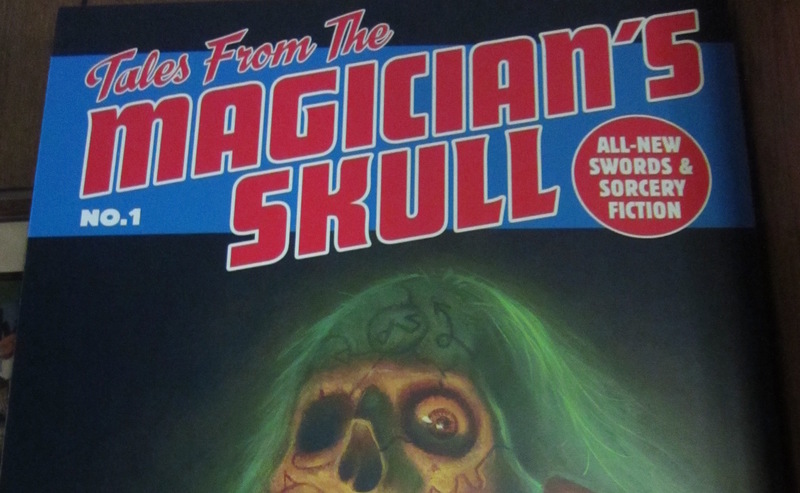
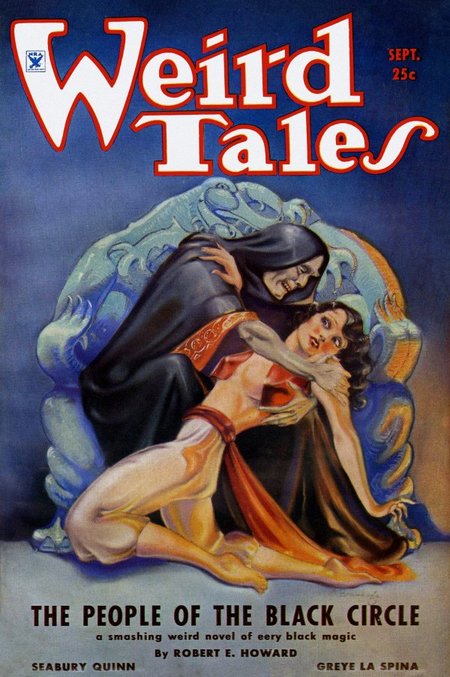
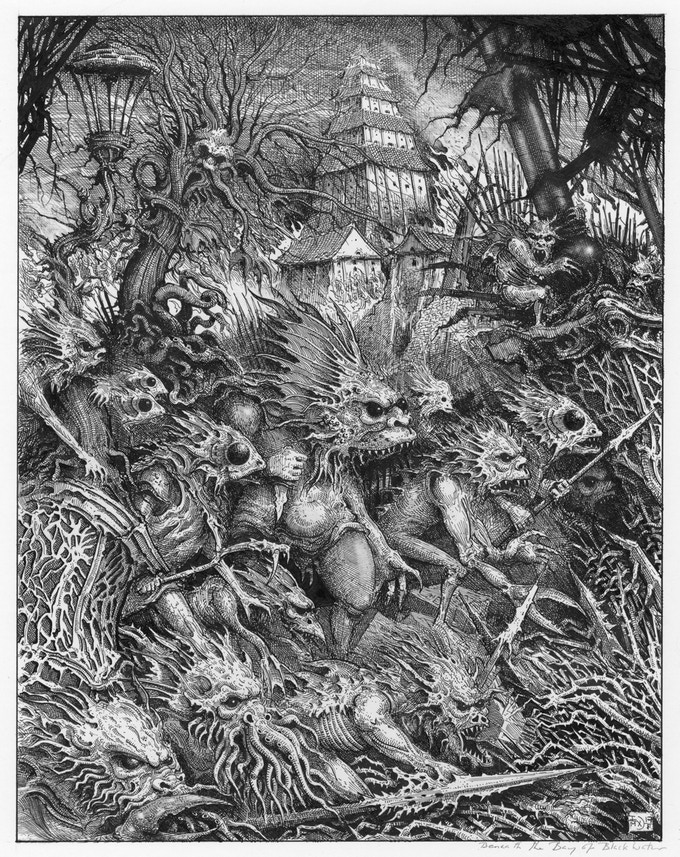
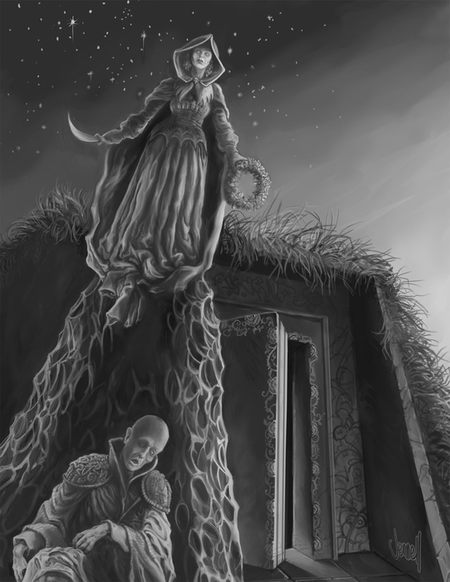
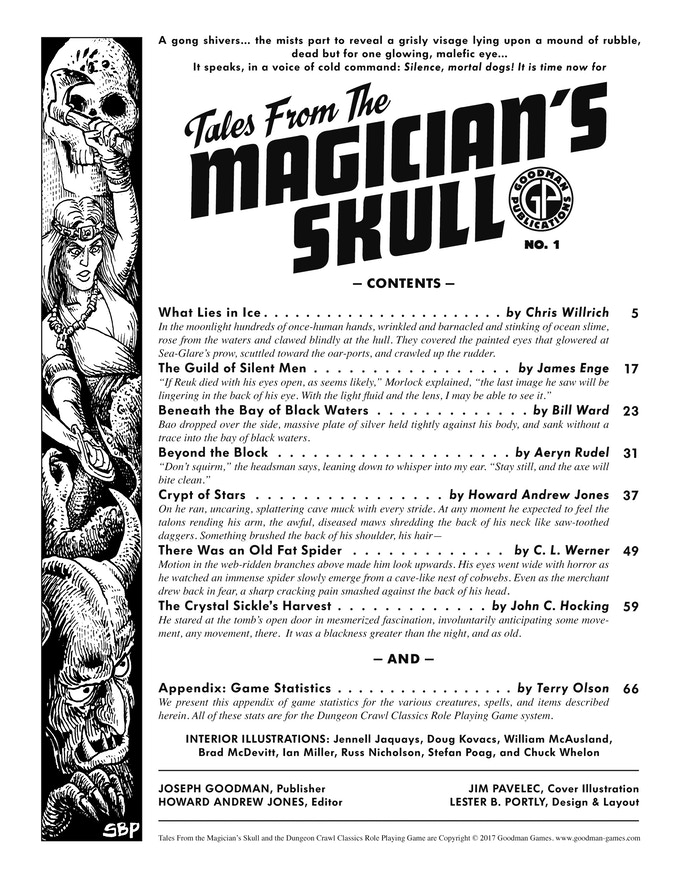
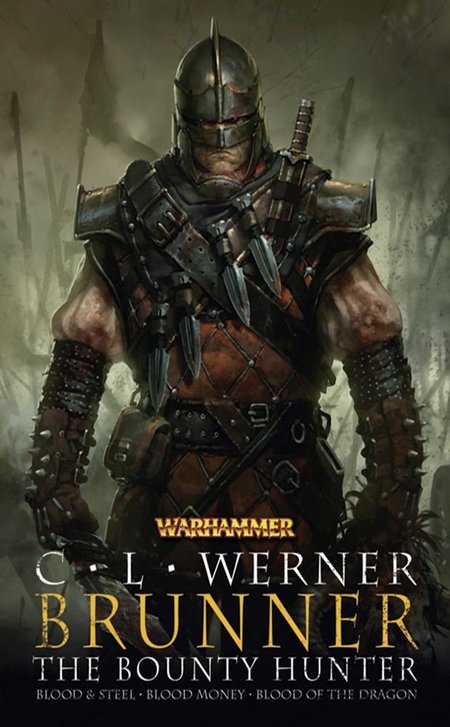
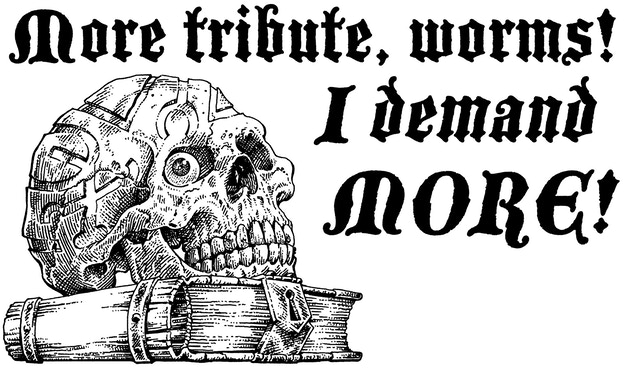
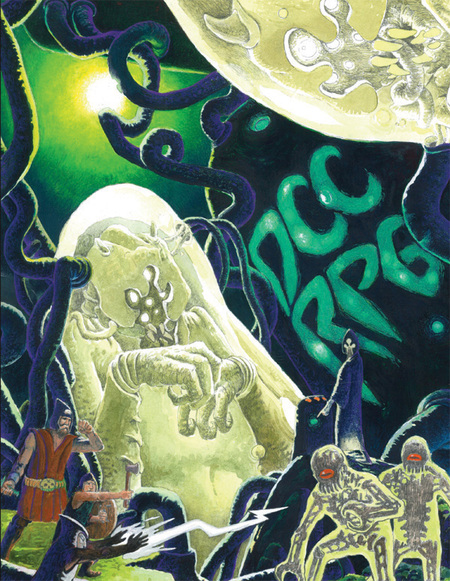
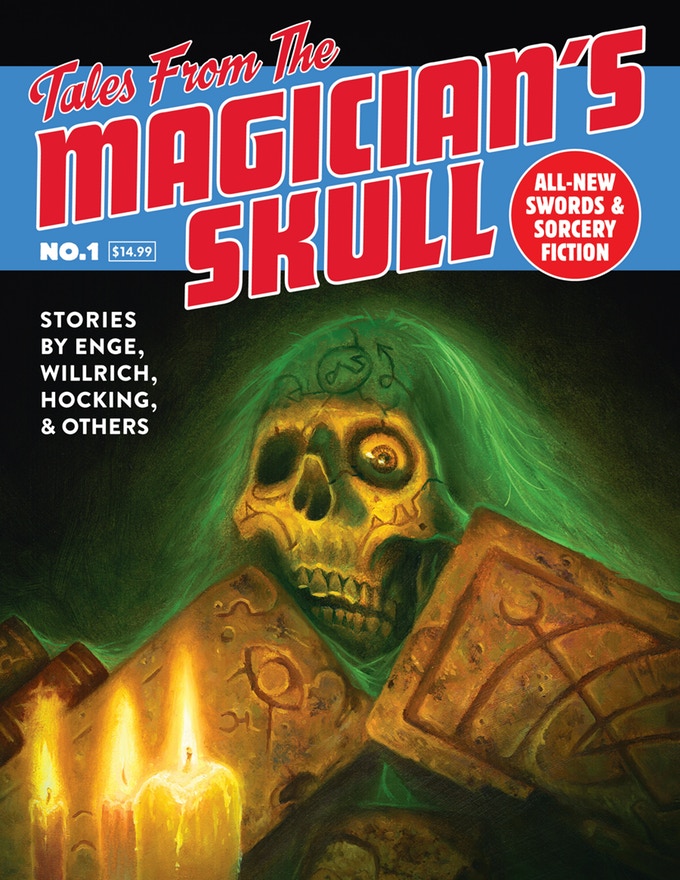
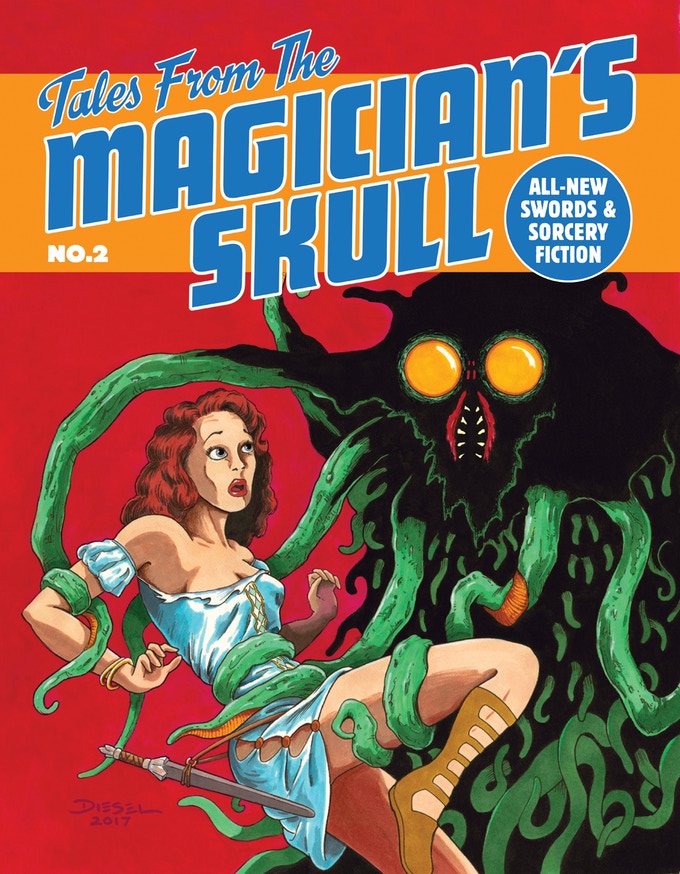
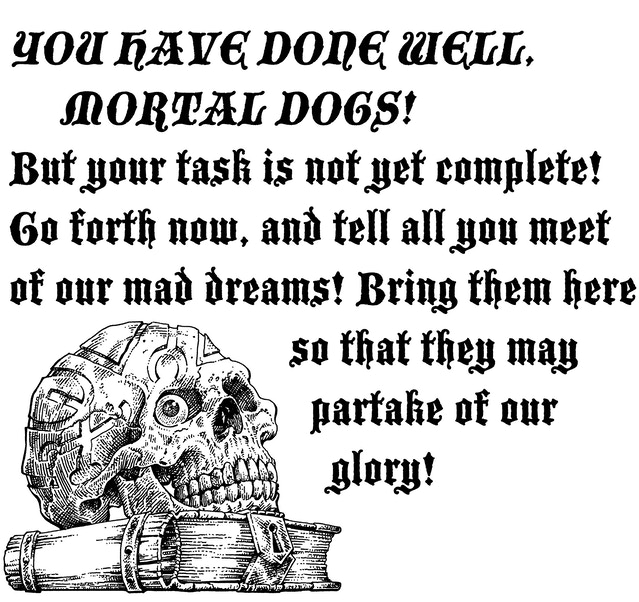
Thanks for the interview, John! I backed Tales from the Magician’s Skull when you first mentioned it. Love seeing another zine where this type of short fiction can be published.
Partly from Goodman Games’ influence, I’ve also recently started an Appendix N book club with players from my 5E campaign. We just read and discussed ERB’s At the Earth’s Core. Probably going to read Vance’s Dying Earth stories next. Hope to do a DCC one-shot in the future.
Backed it as well! So looking forward to this project.
Ok, I see your point, but can we expect at least a little ape-on-human carnage?
Oh, almost surely at some point. Just not EVERY issue. Mog was particular.
So excited for this mag! Kudos to everyone involved–WE NEED THIS. Weird Tales used to be “The Magazine That Wouldn’t Die.” Well, it’s becoming plain to me that Sword-n-Sorcery is “The Genre That Wouldn’t Die.” Today there are precious few venues that will publish it–R.I.P. BLACK GATE magazine!–so whenever a magazine like TALES FROM THE MAGICIAN’S SKULL (or WEIRDBOOK or AUDIENT VOID or SKELOS) comes along, it creates more opportunity for S&S to thrive, grow, and survive in the 21st Century. Someone always does something clever with it, and writers will keep doing so as long as publishers keep publishing those stories.
Now excuse me while I go write something for that infernal skull…
[…] case you missed it, John O’Neill at Black Gate held an interview with me and Joseph Goodman and the Magician’s Skull […]
John,
Yeah. I keep holding out hope that “The Magazine That Wouldn’t Die” hasn’t died yet… but those hopes get dimmer and dimmer. There hasn’t been an issue of WT since 2014.
I just upgraded my pledge to the Legion Of the Skull level. With all the new goodies announced with that level I couldn’t resist.
I also fear that Weird Tales has finally taken a dirt nap. It’s sad. You’d think someone would grab that mantel and at the very least create a yearly anthology with it.
@A. Walter
I didn’t see that level before. I just upgraded my pledge to that as well.
Insert “Take my money NOW!” meme!
[…] N (Black Gate) In Search of a new Weird Tales: An Interview with Joseph Goodman, Howard Andrew Jones, and the Talki… — “In the 1982 edition of the Advanced Dungeons & Dragons Dungeon Master’s Guide, […]
[…] N (Black Gate) In Search of a new Weird Tales: An Interview with Joseph Goodman, Howard Andrew Jones, and the Talki… — “In the 1982 edition of the Advanced Dungeons & Dragons Dungeon Master’s Guide, […]